|
THE CARTRIDGE COLLECTOR'S EXCHANGE |
| Contents
Cartridge
Lists
Prior Picture Pages:
Links to Other Sites
Cartridge Collectors Organizations:
Auctions:
Books:
Other Collector's Sites:
|
Home of the Old Ammo Guy's Virtual
Cartridge Trading Table
Picture Page October 2006 A progression of U.M.C. .38 S&W boxes, Part 2:
Last month, I included a couple of U.M.C. .38 Smith &Wesson boxes which had early S&W pistols illustrated on the top labels. The top labels of the remaining boxes I will discuss include illustrations of the cartridge, and not the pistol that they were intended for. However, this box continues to tout 'Smith & Wesson's .38 Caliber Automatic Ejecting Revolvers'. While there are no cartridges in the box, the illustration on the label would indicate that they were of the externally lubricated type, most likely with the long, grooved Merwin & Hulbert style bullets that the earlier boxes held. In addition, the illustration shows no headstamp on the cartridge, which would suggest that this box was probably not made after 1885, when U.M.C. began applying headstamps. The new U.M.C. in a double lined oval logo with the words 'Trade Mark' underneath appears on both sides of the label. Referred to in its various forms as the U.M.C. lozenge, the UMC logo was first used by the company in 1885. Therefore, based on the unheadstamped cartridge and the use of the logos on the label, it would appear that this box was probably made in about 1885. The reference to 'central fire', much more prominent on this label compared with earlier labels, will be seen on the box labels that will follow in succeeding months. It was used throughout UMCs centerfire cartridge production, and continued to be used by Remington Arms Company-UMC for some time after the two companies merged in 1912. In contrast, the Winchester Repeating Arms Company made the change from 'central fire' to 'center fire' around 1890, sensing perhaps at that time that the earlier wording had become obsolete with its ammunition customers. Included on the top label also is the statement 'With U.M.C. No. 0 Primers'. There is an orange label inside the top indicating that only the U.M.C. 0 primer should be used for reloading the fired cases. As if there wasn't enough already included on the top label, a final line was provided at the bottom to advise UMCs more economy-minded potential customers that 'These shells can be reloaded many times'. Unfortunately, the first sign of the need to retire one of these reloaded folded head cases was likely to be a split head, which would spew hot gases and bits of brass to either side of the revolver, proving a potential hazard to anyone standing beside the shooter. The side sealing label somewhat matches those of the earlier boxes, with the signed Smith & Wesson statement on one side and their signature on the other, as on the earlier boxes, and is marked '.38 S.&W.' on the ends. This is the earliest box I have that has the familiar orange guarantee label that was attached for many years to the bottoms of UMC boxes, and continued to be used after the merger of UMC and the Remington Arms Company. This particular version of the label guarantees the cartridges when used in the following makes of firearms: Colt, Winchester, Marlin, Bullard, Whitney, Smith & Wesson, Ballard, Stevens, Wesson, and Remington, and then includes the catch-all phrase 'and others of first-class manufacture'. Many of the firearms whose names were listed on this label ceased production shortly after this box was produced, including Wesson and Whitney in 1888, Bullard in 1890, and Ballard in 1891. Consequently, the list of named firearms will vary throughout their period of use of these labels. .
Made sometime, I believe, between about 1886 and 1890, this box label has an illustration of a cartridge that has an inside lubricated bullet as well as a headstamp. The U.M.C. S .38 S&W. H headstamp and the new style bullet match those of the 50 cartridges that are contained within the box. In addition, the cartridge cases used were also of a new design, having solid heads, as the 'S' and 'H' on the headstamp attest, rather than the earlier folded heads. On these new cases, the head was cast in place, rather than being formed by a turning process from a drawn out brass 'cup'. The solid head cases were stronger, and solved the problem of head splits satisfactorily for many years until heavy loads of smokeless powder necessitated a stronger design. end label not so marked. A different UMC logo, this one having a black background, makes its appearance on this label, and this time, just one is used. I believe this logo made its appearance about the same time, or shortly after the logo on the box above. The weights of the bullet (148 grains) and the black powder charge (15 grains) make their appearance to the right of the bullet illustration. The side sealing label has the Smith & Wesson signed statement on one side; the signature on the other side has been replaced with the following: 'Adapted to Smith and Wesson's and other Revolvers, Are sure fire and accurate. The U. M. C. Co.'. The ends are marked '.38 S.&W.' and now include 'Central Fire.' underneath. The guarantee label, worn and almost illegible, lists the same makes of firearms as on the box above, but is formatted slightly differently, having had the words 'and shells' removed from the the portion of the guarantee that says UMC guarantees 'the following named arms when being used with the U.M.C. cartridges and shells'. The change may have reflected a perception that the company guarantee extended to reloaded ammunition at a time when smokeless powder was being developed. An orange label inside the top says 'Use only U.M.C. No. 0 PRIMERS in reloading these cartridges'.
. Common pistol, uncommon caliber ......
. . . . . . . . Pictured here is a relatively common single shot derringer manufactured
between 1865 and 1867, most likely by the Bacon Arms Company, for New York
City arms agents Joseph Merwin & Edward P. Bray. Joseph Merwin is
better known for his later association with Merwin, Hulbert & Company, and
during his association with Bray was a sales agent for the Ballard
rifle and the . . . Common cartridge, not too common bullet...........
. |

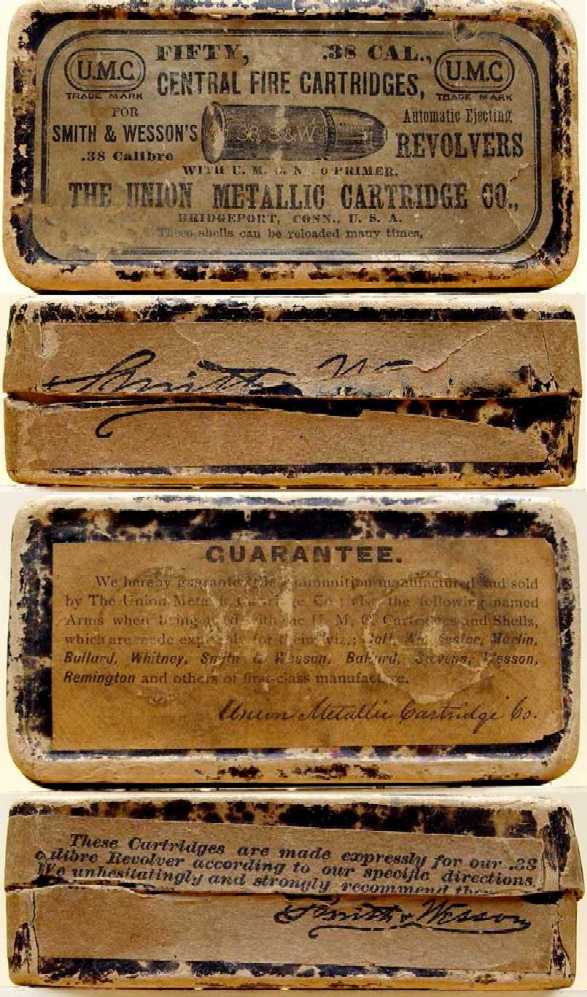
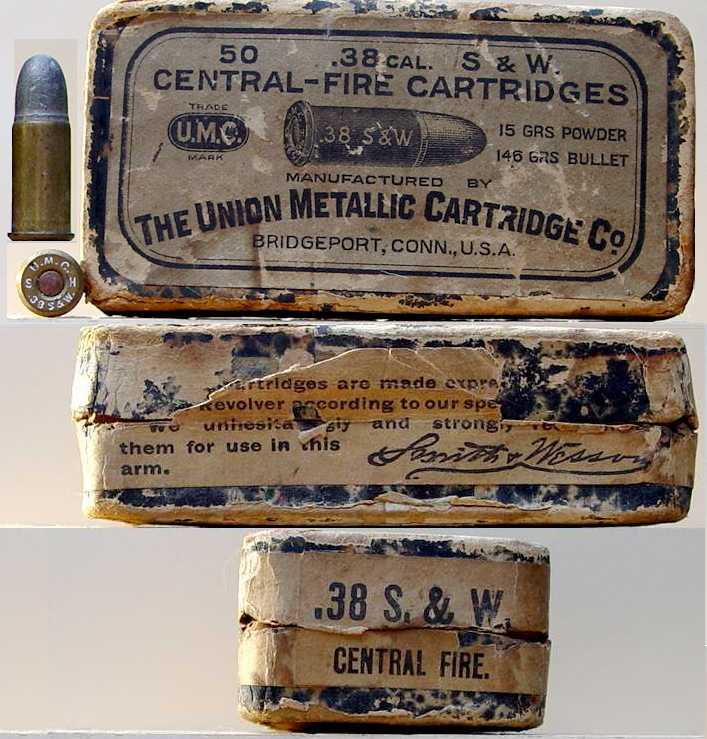
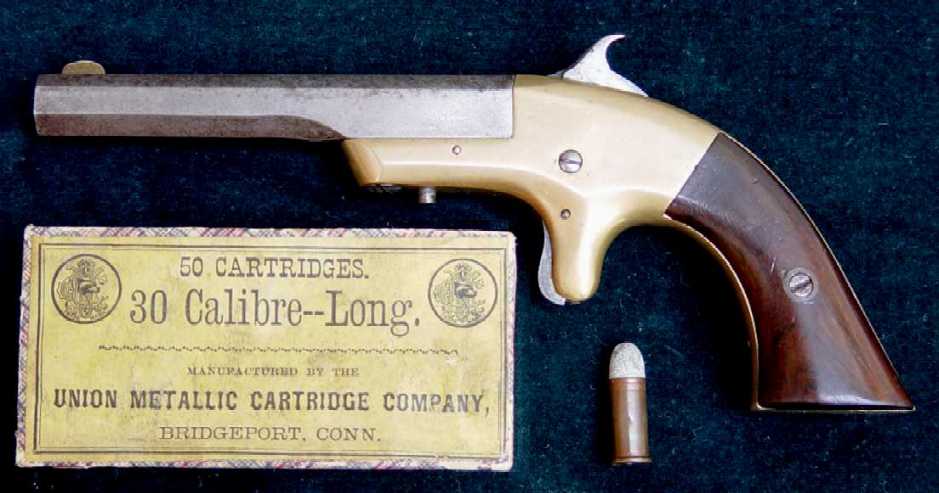
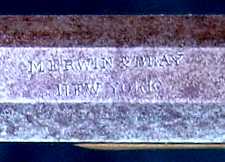 Plant
front-loading revolver. Pistols like the one shown here will be found marked
Bacon Manufacturing Company, H.C. Lombard & Company, and Morgan &
Clapp, in addition to Merwin & Bray as shown shown in this picture. All of the information I have been able
to find on this pistol indicates that it was made for Merwin & Bray only in
.22 and .32 caliber rim fire, yet this one takes the .30 long rim fire.
Plant
front-loading revolver. Pistols like the one shown here will be found marked
Bacon Manufacturing Company, H.C. Lombard & Company, and Morgan &
Clapp, in addition to Merwin & Bray as shown shown in this picture. All of the information I have been able
to find on this pistol indicates that it was made for Merwin & Bray only in
.22 and .32 caliber rim fire, yet this one takes the .30 long rim fire. 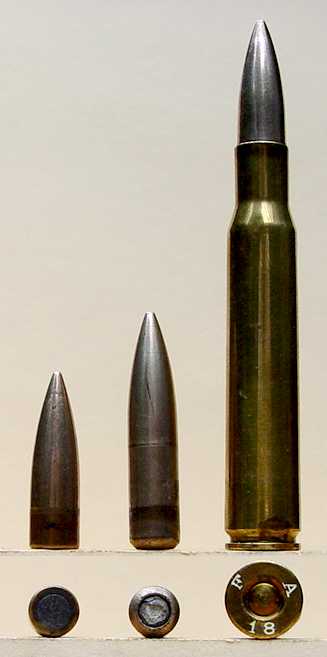 Pictured on the right
side in this picture is a Frankford Arsenal .30-06 cartridge made in 1918
that, from its outward appearance, looks pretty ordinary. However, these
common looking cartridges sometimes hold a surprise. The profile of the
exposed portion of the bullet looks quite similar to the profile of the
standard M1 ball that was used at the time, shown on the left in the
picture. The
cartridge on the right was one of three that were found, oddly enough, in a
cigar box full of .30-06 cartridges which were destined to go into my junk
bucket, to be sorted through on the next rainy day. The necks of all three
were cracked, and on a whim I slipped one of the bullets out; much to my
surprise, it was an oddity that I didn't recognize. The other two had
matching bullets. As can be seen in the picture, the bullet has a short,
sharply angled boat-tail, and an exposed lead core. It does not attract a
magnet, and its overall length is 1.454". My first thought was
that these were incendiary cartridges, and they resembled one of those
illustrated in Hackley, Scranton, and Woodin's volume 1 of History of
Modern U.S. Military Small Arms Ammunition. However, after posting a
question about this bullet on
the International Ammunition Association's cartridge forum, I found that
these are actually tracers, which will be found in a variety of shapes and
sizes in these 1918 headstamped cases.
Pictured on the right
side in this picture is a Frankford Arsenal .30-06 cartridge made in 1918
that, from its outward appearance, looks pretty ordinary. However, these
common looking cartridges sometimes hold a surprise. The profile of the
exposed portion of the bullet looks quite similar to the profile of the
standard M1 ball that was used at the time, shown on the left in the
picture. The
cartridge on the right was one of three that were found, oddly enough, in a
cigar box full of .30-06 cartridges which were destined to go into my junk
bucket, to be sorted through on the next rainy day. The necks of all three
were cracked, and on a whim I slipped one of the bullets out; much to my
surprise, it was an oddity that I didn't recognize. The other two had
matching bullets. As can be seen in the picture, the bullet has a short,
sharply angled boat-tail, and an exposed lead core. It does not attract a
magnet, and its overall length is 1.454". My first thought was
that these were incendiary cartridges, and they resembled one of those
illustrated in Hackley, Scranton, and Woodin's volume 1 of History of
Modern U.S. Military Small Arms Ammunition. However, after posting a
question about this bullet on
the International Ammunition Association's cartridge forum, I found that
these are actually tracers, which will be found in a variety of shapes and
sizes in these 1918 headstamped cases.